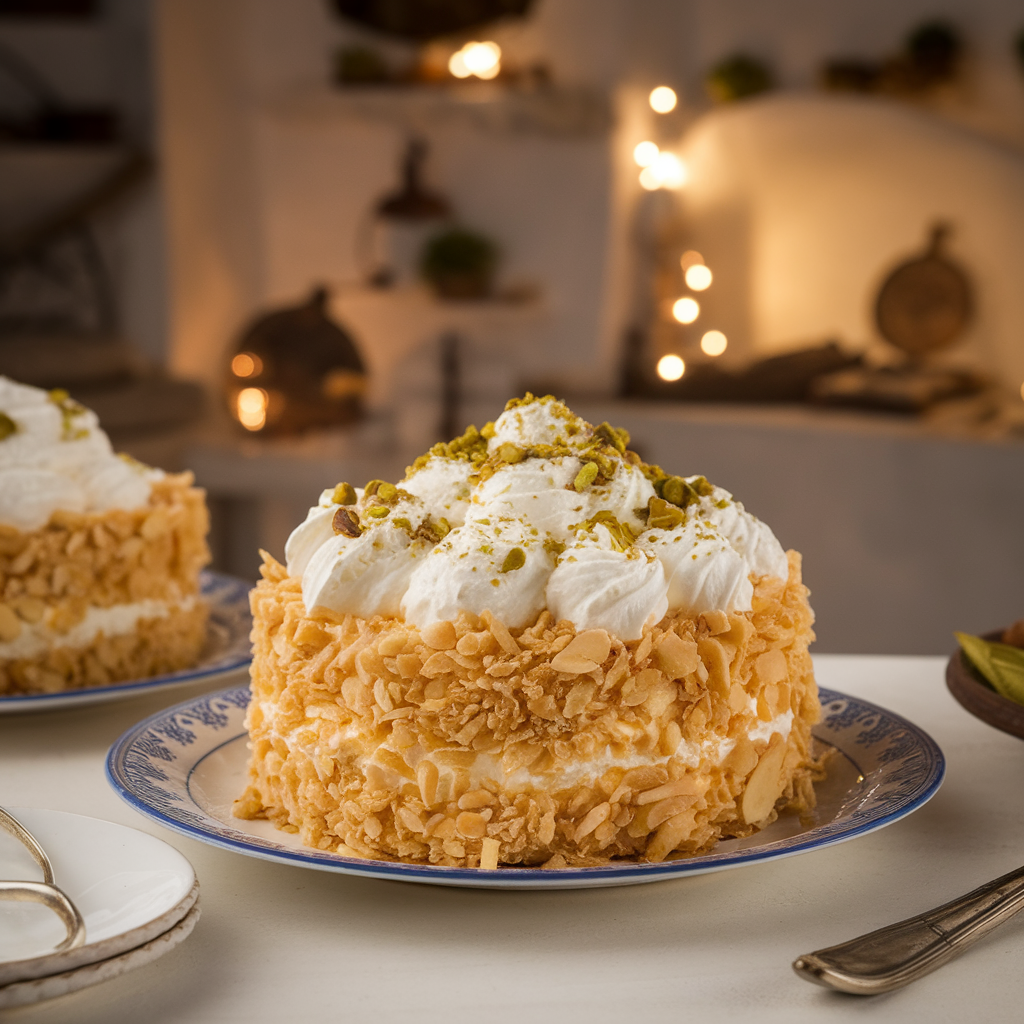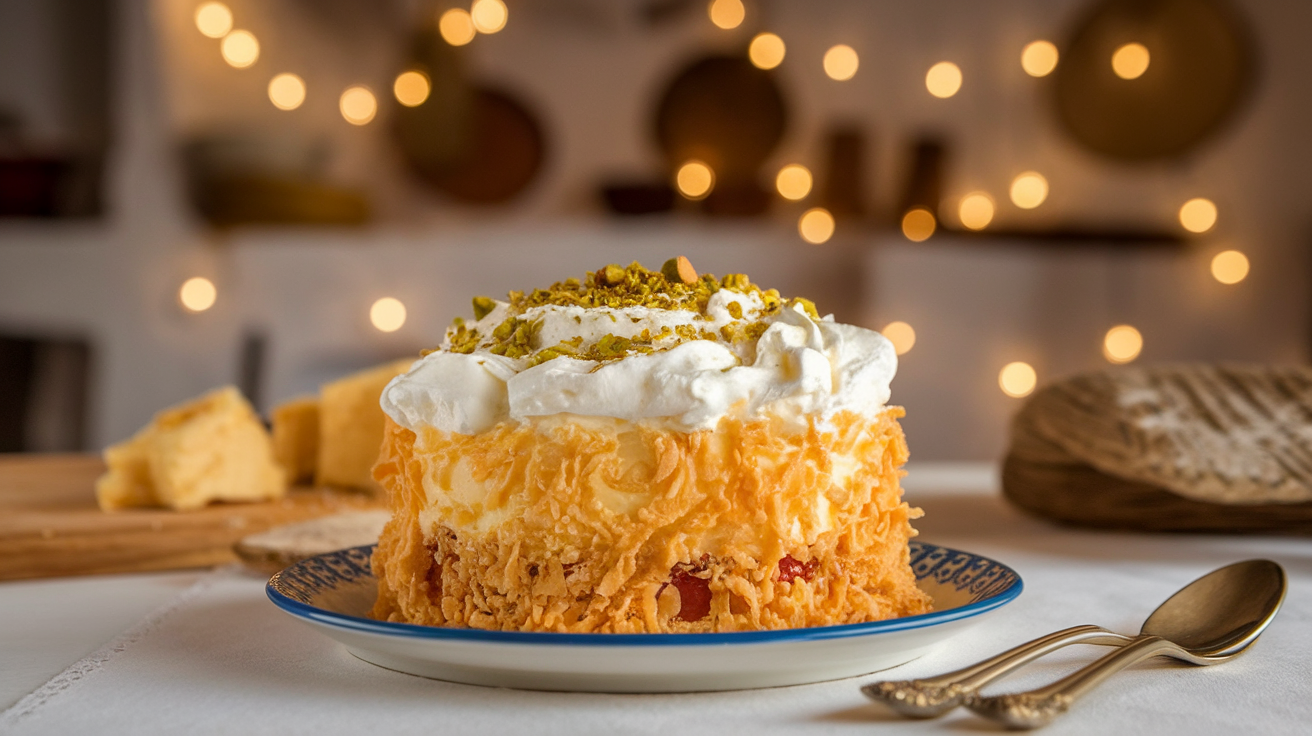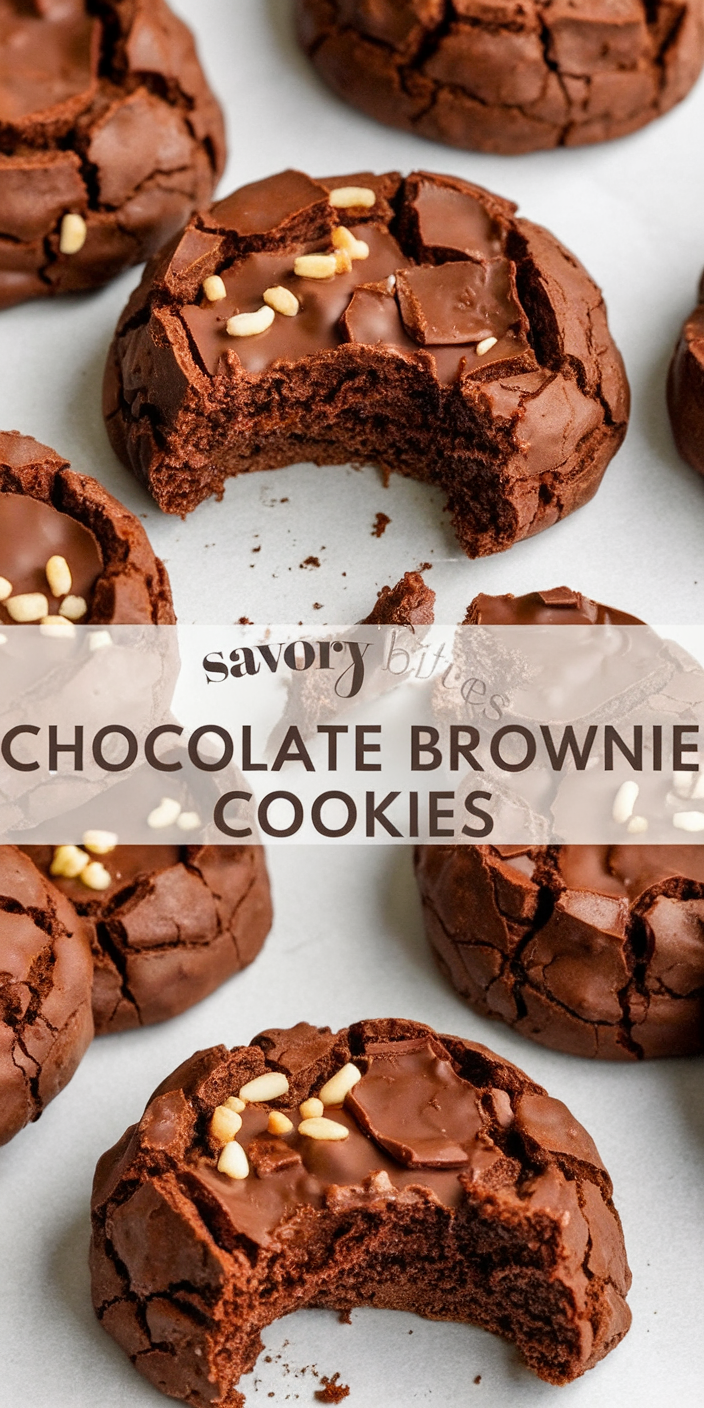The culinary world of the Mediterranean is a treasure trove of unique textures, rich flavors, and centuries-old traditions. Among these culinary gems, Greek Ekmek Kataifi stands out as a decadent dessert that combines crispness, creaminess, and sweetness in perfect harmony. If you love exploring Greek pastries desserts or are simply searching for new tray dessert recipes to wow your guests, this kataifi dessert is an excellent choice.
In this article, we embark on an extensive exploration of the Ekmek Kataifi recipe, uncovering its history, ingredients, preparation techniques, and variations. We also discuss related dishes like the Ashta dessert, other kadaif desserts, and the role of desserts with whipping cream in Mediterranean sweets. Whether you’re a professional chef, a passionate home cook, or a dessert enthusiast, this guide will provide everything you need to master this sumptuous treat.
Understanding Kataifi: The Unique Shredded Phyllo Dough
At the heart of Ekmek Kataifi is kataifi dough—a special shredded phyllo dough that distinguishes it from other pastries. Unlike regular phyllo sheets, kataifi consists of extremely fine, thread-like strands of dough, which bake into a delicate, crunchy nest.
Origin and Usage of Kataifi
The use of kataifi dough is widespread in Middle Eastern, Greek, and Turkish cuisines. It lends itself to both sweet and savory dishes, making it highly versatile. In savory dishes, kataifi can be wrapped around cheese, minced meat, or vegetables, baked or fried to achieve a golden, crunchy exterior. In sweets, it is often layered with nuts, soaked in fragrant syrups, or, as in Ekmek Kataifi, paired with custard and cream for a multi-textural experience.
Kataifi vs Kadaif
You might encounter the terms kataifi y kadaif used interchangeably. They refer to the same shredded dough but differ in spelling depending on regional languages. Both play vital roles in Mediterranean and Middle Eastern dessert traditions.
Ekmek Kataifi: The Name and Its Significance
“Ekmek” literally means “bread” in Turkish and Greek, reflecting the custard layer’s bread-like density and structure. This custard is a thick, creamy foundation that balances the crispy kataifi and the lightness of whipped cream. Together, the layers create an exquisite texture contrast that is both comforting and indulgent.
Detailed Ingredients Breakdown
Let’s explore the ingredients to understand their roles and how they contribute to the final product:

Kataifi Dough and Butter
The kataifi strands require generous coating with melted butter, which facilitates crispness and rich flavor. The butter not only adds taste but also ensures the shredded dough bakes evenly without drying out.
Sugar and Cinnamon
A sprinkle of sugar caramelizes slightly during baking, adding subtle sweetness and crunch. Cinnamon, though optional, adds warm, aromatic notes that complement the richness of the custard and cream.
Custard Base
The custard is the soul of the dessert. Made traditionally with milk, egg yolks, flour, sugar, and butter, it’s thickened to a velvety consistency. Vanilla extract enhances flavor depth, while the butter enriches the custard, creating a creamy mouthfeel.
Whipping Cream
Topping the dessert with whipped cream introduces a fluffy, light texture that cuts through the richness of the custard and the density of the kataifi base. The addition of powdered sugar and vanilla extract makes the cream subtly sweet and aromatic.
Nuts and Floral Waters
Garnishing with crushed nuts like pistachios or walnuts adds a crunchy element and a vibrant color contrast. The use of rose water or orange blossom water is traditional in many Mediterranean desserts, imparting a delicate floral fragrance that elevates the overall sensory experience.
Step-by-Step Preparation with Culinary Tips
Step 1: Preparing the Kataifi Base
- Handling kataifi dough: Kataifi dough is delicate and dries out quickly, so work with it as soon as possible after unwrapping.
- Even butter distribution: Melted butter should be drizzled slowly while gently pulling apart the kataifi strands. This ensures uniform coating for a consistent texture.
- Baking: Spread the kataifi in a buttered tray and bake until it is golden and crisp. Avoid opening the oven too frequently to prevent heat loss, which can affect crispness.
Step 2: Making the Custard
- Tempering eggs: Slowly adding hot milk to the egg mixture while whisking prevents the eggs from curdling.
- Constant stirring: Use a whisk or wooden spoon to stir the custard continuously while heating, ensuring a lump-free, smooth texture.
- Cooling: Cover the custard surface with plastic wrap pressed directly onto it to prevent a skin from forming.
Step 3: Whipping the Cream
- Chilling: For the best whipping results, chill your bowl and beaters in the freezer for 10-15 minutes.
- Whipping: Beat heavy cream with powdered sugar and vanilla until soft peaks form. Over-whipping can cause the cream to become grainy and separate.
Step 4: Assembling the Dessert
- Layering: Spread the cooled custard evenly over the kataifi base to create a stable and creamy middle layer.
- Final topping: Gently spread whipped cream to avoid disturbing the custard layer.
- Guarnición: Finish with crushed nuts and optionally a dusting of cinnamon or a drizzle of syrup.
Step 5: Chilling
- Refrigerate the assembled dessert for several hours or overnight. This allows the flavors to meld and the kataifi to soften slightly under the custard and cream, while still retaining some crunch.
Exploring Related Mediterranean Desserts
Ashta Dessert and Its Influence
Ashta is a clotted cream-based Middle Eastern dessert often served with syrup-soaked pastries or fruits. The whipped cream layer in Ekmek Kataifi is reminiscent of ashta in both texture and richness, demonstrating the culinary dialogue between Greek and Middle Eastern sweets.
Custard Pastries in Mediterranean Cuisine
The custard used in Ekmek Kataifi shares similarities with custard fillings found in other Mediterranean pastries such as Galaktoboureko (a Greek custard pie) and Bougatsa (a Greek breakfast pastry). Custard provides a creamy, sweet balance to flaky or crunchy pastry components.
Kadaif Dessert Variations
Beyond Ekmek Kataifi, the shredded kataifi dough is used in numerous other sweets:
- Kataifi rolls: Rolled around nuts and soaked in syrup.
- Kataifi nests: Shaped into small nests filled with nuts or cream.
- Savory kataifi: Filled with cheese or minced meat for appetizers.

Savoury Kataifi Recipe Ideas
While this article focuses on the sweet Ekmek Kataifi, kataifi dough’s unique texture lends itself well to savory preparations:
- Cheese-stuffed kataifi: Fresh white cheese or feta wrapped in kataifi, baked until crisp.
- Spinach and herb bundles: A delicious vegetarian appetizer using spinach, herbs, and kataifi dough.
- Seafood kataifi: Shrimp or fish fillets wrapped and fried in kataifi for a crunchy crust.
These savoury dishes highlight kataifi’s versatility beyond desserts and are popular in Greek, Turkish, and Lebanese cuisines.
Tray Dessert Recipes: Perfect for Sharing
Ekmek Kataifi is a classic example of a tray dessert recipe, ideal for celebrations, family gatherings, or catering events. Its layered presentation looks impressive and is easy to serve in slices. This makes it a go-to dessert when feeding larger groups, offering a crowd-pleasing combination of textures and flavors.
Why Desserts with Whipping Cream Are So Popular
Whipping cream is a key ingredient in many luxurious desserts because it:
- Adds a light, fluffy texture that balances rich components.
- Can be flavored easily with vanilla, spices, or floral waters.
- Provides visual appeal with soft peaks and a snowy white finish.
- Enhances mouthfeel, offering a melt-in-the-mouth sensation.
In Ekmek Kataifi, the whipped cream topping completes the dessert by adding an airy contrast to the crispy kataifi and thick custard, creating a complex yet harmonious experience.
Cultural Significance and Occasions
In Greece, Ekmek Kataifi is often served at celebrations, weddings, and holidays. Its richness symbolizes abundance and hospitality. Making this dessert from scratch is a way to honor tradition and showcase culinary skills. It also reflects the region’s historical connections with Ottoman and Middle Eastern cuisine, where kataifi dough has long been a cherished ingredient.

Serving Suggestions and Pairings
To elevate your Ekmek Kataifi experience, consider pairing it with:
- Greek coffee or strong black tea: The bitterness contrasts the sweetness.
- Fresh fruits: Berries or pomegranate seeds add freshness and color.
- Light dessert wines: Such as Muscat or a sweet retsina to complement the creaminess.
For a modern twist, serve with a drizzle of homemade honey syrup infused with lemon zest or cinnamon for added aroma.
Storage Tips and Shelf Life
Ekmek Kataifi is best enjoyed within 2-3 days of preparation. Store it covered in the refrigerator to maintain freshness. The kataifi base may soften slightly over time due to the moist custard and cream layers, but this is natural and still delicious.
Troubleshooting Common Issues
- Kataifi not crispy: Ensure even butter coating and bake long enough at moderate heat.
- Custard lumps: Whisk continuously and temper eggs properly by slowly adding hot milk.
- Whipped cream too soft or too stiff: Chill bowl and cream before whipping; stop whipping at soft peaks.
- Dessert too sweet: Adjust sugar quantities or balance with a pinch of salt in custard.
Conclusion: The Perfect Balance of Tradition and Taste
El Greek Ekmek Kataifi recipe beautifully encapsulates the essence of Mediterranean desserts—rich, layered, and texturally diverse. This dessert brings together the signature crispness of kataifi dough, the creamy depth of custard, and the delicate lightness of whipped cream, all finished with crunchy nuts and aromatic spices.
Si usted está explorando Greek pastries desserts, seeking new tray dessert recipes, or experimenting with kadaif dessert variations, this recipe offers a rewarding challenge and a delicious payoff. The influence of Ashta dessert, the role of desserts with whipping cream, and the diverse applications of kataifi dough highlight the interconnected culinary traditions of the region.
Try making Ekmek Kataifi at home to delight your family and guests with a timeless taste of Greece. With patience and care, you can create a masterpiece that honors tradition while indulging your sweet tooth.


